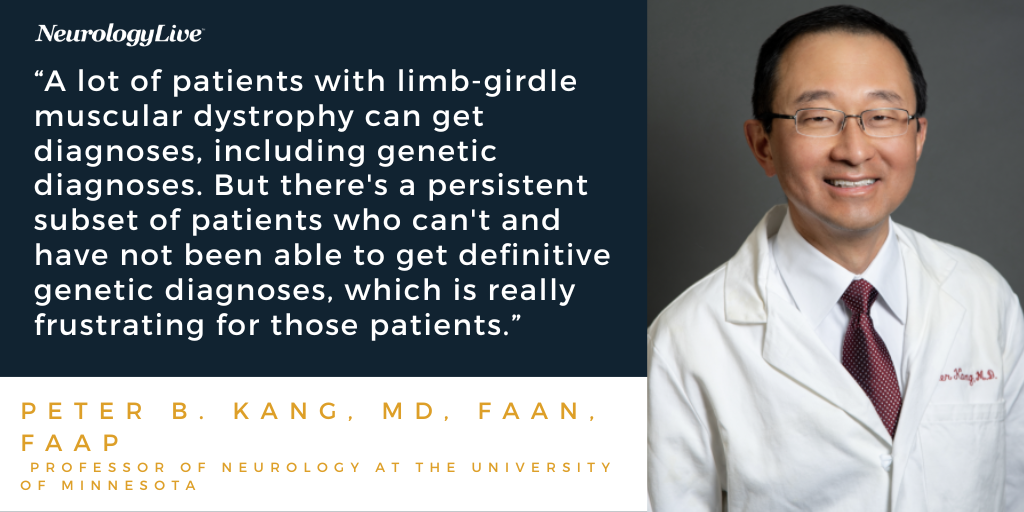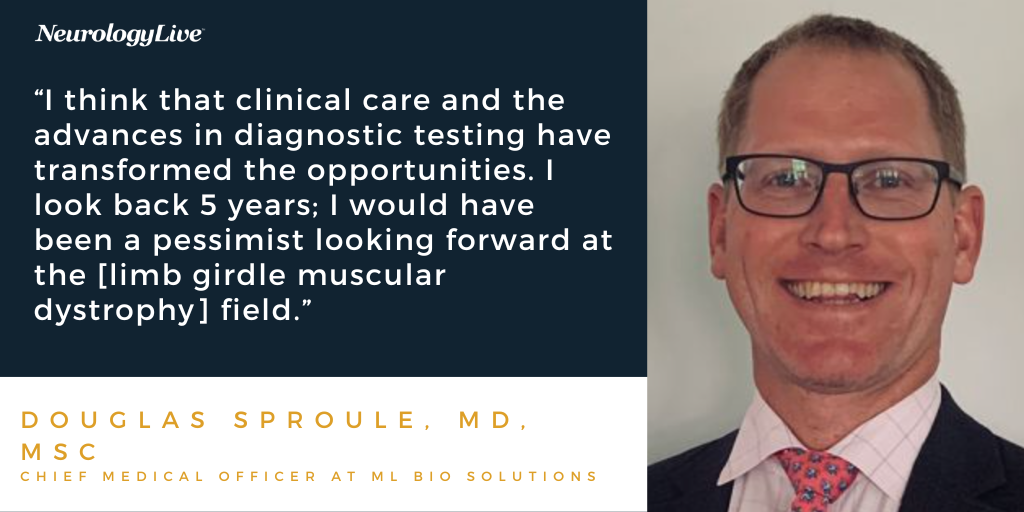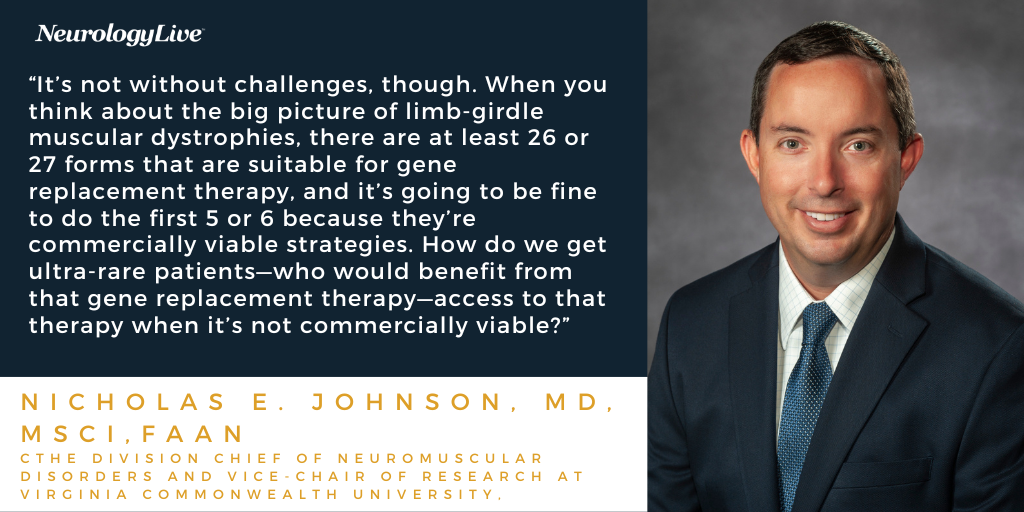News
Article
Neuro News Roundup: LGMD Awareness Day – Expert Insight and Latest Literature
Author(s):
In honor of Limb-Girdle Muscular Dystrophy Awareness Day, held September 30, 2023, get caught up on some of the latest news in LGMD, with data updates and expert insights all in one place from the NeurologyLive® team.
The NeurologyLive® team has been hard at work in the year conducting interviews with thought leaders and covering the news on the latest updates in the clinical care of individuals with neuromuscular disorders such as limb-girdle muscular dystrophy (LGMD), and others.
For Limb-Girdle Muscular Dystrophy Awareness Day — September 30, 2023 —our team offers an update on those new developments in the literature and insight into the expert opinions about how they’re shaping the ever-changing care paradigm in LGMD into one place.
Click here for more coverage of the latest neuromuscular news from NeurologyLive®.
EXPERT INSIGHTS
Peter Kang, MD, FAAN, FAAP, director of the Paul and Sheila Wellstone Muscular Dystrophy Center and professor of neurology at the University of Minnesota, served as the chair in an ultra-rare disease session focused on LGMD at the 2023 Muscular Dystrophy Association (MDA) Clinical & Scientific Conference, March 19-22, in Dallas, Texas. Kang sat down with NeurologyLive® in an interview at the conference to provide an overview of the current knowledge of LGMD with regard to diagnosis and potential therapies. Additionally, he talked about the lingering challenges that patients are facing and the greatest advancement of care in the field. In contrast, Kang also spoke about the unmet needs in research and care for LGMD.
Douglas Sproule, MD, MSc, chief medical officer at ML Bio Solutions, and colleagues presented preliminary results from a phase 2 study (NCT04800874) of BBP-418 for LGMD2I at the annual MDA Clinical & Scientific Conference, held in Dallas, Texas, March 19-22, 2023. Sproule sat down with NeurologyLive® in an interview at the conference to talk about the recent advancements in clinical care with neuromuscular diseases including LGMD. He also spoke about molecular testing in the diagnosis of LGMD. In addition, he talked about the pathway to gene therapies and how industry partners help move the field forward in research.
Nicholas E. Johnson, MD, MSci, FAAN, the division chief of neuromuscular disorders and vice-chair of research at Virginia Commonwealth University, sat down with NeurologyLive® at the 2022 MDA Clinical and Scientific Conference, March 13-16, in Nashville, Tennessee, to discuss the advances and the challenges in LGMD care. Johnson also shared the importance of improving another precision approach: precise genetic diagnoses. Improving the delivery of gene therapy approaches begins with the parallel improvements in genetic diagnoses, ensuring that patients get the proper therapy without the risk of irreversible harm.
LATEST LITERATURE
Dosing Commenced in Phase 3 FORTIFY of Limb-Girdle Muscular Dystrophy Type 2i
In recent news, BridgeBio Pharma announced its first patient dosed in its phase 3 FORTIFY clinical trial (NCT05775848) of BBP-418, an investigational oral substrate supplementation therapy in development for LGMD type 2I/R9 (LGMD2I/R9).1 As of now, the company has initiated over half of the planned clinical sites in the United States and is currently in the process of opening more sites in Europe and Australia to support global registration.
The company also recently met with the FDA to discuss the use of glycosylated α-dystroglycan levels, which are central to LGMD2I/R9 disease, as a surrogate end point in FORTIFY. Following the meeting, BridgeBio Pharma believes that there is potential for an accelerated approval pathway for BBP-418, with findings from the ongoing open-label phase 2 study (NCT04800874) as supportive data. Findings from the study thus far have suggested that the treatment may be well-tolerated and have a positive impact on key end points.2
FORTIFY is a randomized, double-blind, placebo-controlled study aimed at investigating the safety and efficacy of BBP-418. The trial has a planned interim analysis at 12 months with the potential of the results to support an accelerated approval. Patients will be assessed on the North Star Assessment for Dysferlinopathy (NSAD) and several other secondary end points, with findings expected to be announced in late 2024/early 2025 as confirmatory clinical data.
Patient Dosing Commenced in Phase 1/2 Gene Therapy Trial of Limb-Girdle Muscular Dystrophy Type 2I/R9
According to a recent announcement, the first patient has been dosed in the phase 1/2 LION-CS101 clinical trial (NCT05230459) assessing AskBio’s investigational gene therapy AB-1003 for the treatment of limb-girdle muscular dystrophy type 2I/R9 (LGMD2I/R9). Recruitment for the trial remains ongoing.3
LGMD2I/R9, caused by mutations in the FKRP gene, is a form of LGMD that is characterized by weakness and wasting of the muscles in the arms and legs. AB-1003, also known as LION-101, uses an engineered viral vector—an adeno-associated virus (AAV)—to deliver a non-mutated version of the FKRP gene, by a single intravenous infusion. LGMD2I/R9 is a rare disease, estimated to affect more than 5000 people in the US and EU.
The phase 1/2 trial, double-blind, placebo-controlled, and dose-escalation in design, is expected to include 14 adults with genetically confirmed LGMD2I who are followed for a 52-week treatment period. Initiated midway through 2023, the trial’s main goal is safety, assessed through treatment-emergent adverse events (TEAEs), serious AEs, and dose limiting toxicity. Participants will be treated in sequential, dose-level cohorts with 2 arms of different doses and 1 placebo arm.
Efficacy and Tolerability on Display by SRP-9003 Over 2 Years in LGMD2E
Findings from a phase 1/2 study of the AAV-based gene therapy SRP-9003 suggest that treatment with the Sarepta Therapeutics agent resulted in sustained protein expression in muscle tissue and stabilized North Star Assessment for Dysferlinopathies (NSAD) scores at 2 years in patients with limb-girdle muscular dystrophy Type 2E (LGMD2E). The study enrolled children between the ages of 4 and 15 years with significant symptoms.4
The updated data were presented at the MDA 2021 Clinical and Scientific Conference, March 15-18, by Louise Rodino-Klapac, PhD, executive vice president and chief scientific officer, Sarepta Therapeutics. The study included 2 cohorts, both with a different dose of the gene therapy. Cohort 1 (n = 3) included patients who received 1.85 × 1013 vg/kg as a single intravenous infusion, and cohort 2 (n = 3) included those who received it at a dose of 7.41×1013 vg/kg—a dose selected based on findings from cohort 1.
All told, SRP-9003 elicited improvements for functional measures in all patients in the phase 1/2 study, including scores in time-to-rise, four-stair climb, 100-meter walk, and 10-meter walk tests. These were most pronounced in the high-dose group. In the low-dose cohort of the therapy with 2 years of follow-up, with data showing that mean beta-sarcoglycan (beta-SG) expression was increased by 54% in a western blot among treated patients—up from 36% at day 60. Similarly, in the high-dose cohort, the beat-SG expression was 62% at day 60, though long-term follow-up data were unavailable.








